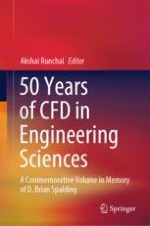
2020 | OriginalPaper | Chapter
Brian Spalding: Some Contributions to Computational Fluid Dynamics During the Period 1993 to 2004
Author : Michael R. Malin
Published in: 50 Years of CFD in Engineering Sciences
Publisher: Springer Singapore
Activate our intelligent search to find suitable subject content or patents.
Select sections of text to find matching patents with Artificial Intelligence. powered by
Select sections of text to find additional relevant content using AI-assisted search. powered by